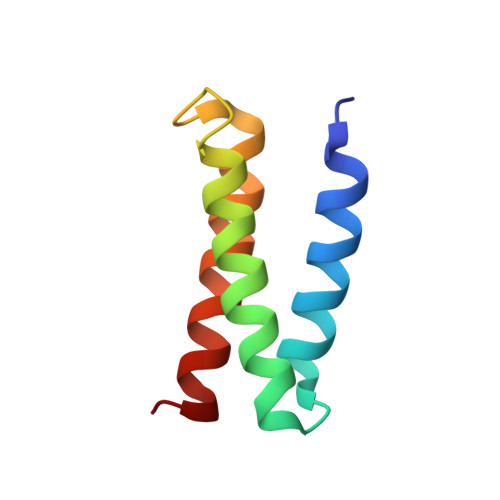Apoprotein Structure and Metal Binding Characterization of a de Novo Designed Peptide, alpha 3DIV, that Sequesters Toxic Heavy Metals.
Plegaria, J.S., Dzul, S.P., Zuiderweg, E.R., Stemmler, T.L., Pecoraro, V.L.(2015) Biochemistry 54: 2858-2873
- PubMed: 25790102
- DOI: https://doi.org/10.1021/acs.biochem.5b00064
- Primary Citation of Related Structures:
2MTQ - PubMed Abstract:
De novo protein design is a biologically relevant approach that provides a novel process in elucidating protein folding and modeling the metal centers of metalloproteins in a completely unrelated or simplified fold. An integral step in de novo protein design is the establishment of a well-folded scaffold with one conformation, which is a fundamental characteristic of many native proteins. Here, we report the NMR solution structure of apo α3DIV at pH 7.0, a de novo designed three-helix bundle peptide containing a triscysteine motif (Cys18, Cys28, and Cys67) that binds toxic heavy metals. The structure comprises 1067 NOE restraints derived from multinuclear multidimensional NOESY, as well as 138 dihedral angles (ψ, φ, and χ1). The backbone and heavy atoms of the 20 lowest energy structures have a root mean square deviation from the mean structure of 0.79 (0.16) Å and 1.31 (0.15) Å, respectively. When compared to the parent structure α3D, the substitution of Leu residues to Cys enhanced the α-helical content of α3DIV while maintaining the same overall topology and fold. In addition, solution studies on the metalated species illustrated metal-induced stability. An increase in the melting temperatures was observed for Hg(II), Pb(II), or Cd(II) bound α3DIV by 18-24 °C compared to its apo counterpart. Further, the extended X-ray absorption fine structure analysis on Hg(II)-α3DIV produced an average Hg(II)-S bond length at 2.36 Å, indicating a trigonal T-shaped coordination environment. Overall, the structure of apo α3DIV reveals an asymmetric distorted triscysteine metal binding site, which offers a model for native metalloregulatory proteins with thiol-rich ligands that function in regulating toxic heavy metals, such as ArsR, CadC, MerR, and PbrR.
Organizational Affiliation:
#Department of Pharmaceutical Sciences, Wayne State University, Detroit, Michigan 48201, United States.














